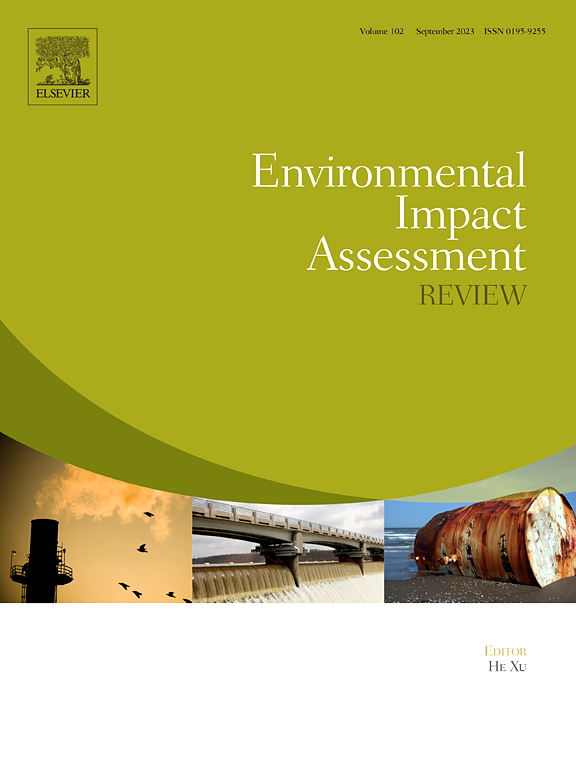Evaluating sawdust-based bioethanol and pyrolysis products in the European Union: Feedstock availability, life cycle assessment, and techno-economic analysis
IF 9.8
1区 社会学
Q1 ENVIRONMENTAL STUDIES
引用次数: 0
Abstract
The significance of biomass-derived biofuels in global transport is increasing due to their perceived environmental advantages and policies with binding use targets. This study conducted a comprehensive sustainability analysis of sawdust-based bioethanol in the European Union, encompassing evaluations of sawdust availability, techno-economic assessment (TEA), and global warming potential (GWP), including land use and land-use-change-related GWP (GWP-LULUC). It was found that bioethanol production based on average annual sawdust potential could replace only 0.5 % of total fuel consumption in the EU transport sector in 2021, provided that all the sawdust was used for this purpose. The TEA calculations indicated that, while technically feasible, the economics of sawdust-based bioethanol production are not favourable based on this research's assumptions. Pyrolysis-based bioproducts showed better profitability. The economics of bioethanol production depends greatly on the sawdust cost, which was shown by the sensitivity analysis conducted. The GWP results highlighted the potential environmental benefits of ethanol-blended fuels such as E20 (20 % bioethanol with gasoline) and E85 (85 % bioethanol with gasoline), demonstrating reductions of 18 % and 78 % in fossil GWP impacts compared to petrol respectively. Examining GWP-LULUC unveiled a notable sequestration effect, primarily due to increased carbon storage in forests. However, these effects vary depending on the production year, country of origin, or soil type. In the context of this study, sawdust-based bioethanol demonstrated the potential to replace some fossil fuels, offering technical feasibility and considerable environmental benefits. However, it is not economically feasible and is highly influenced by policy changes and competition among different sectors.
在欧盟评估基于木屑的生物乙醇和热解产品:原料可用性,生命周期评估和技术经济分析
由于其环境优势和具有约束性使用目标的政策,生物质衍生生物燃料在全球运输中的重要性正在增加。本研究对欧盟以木屑为基础的生物乙醇进行了全面的可持续性分析,包括木屑可用性、技术经济评估(TEA)和全球变暖潜能值(GWP)的评估,包括土地利用和土地利用变化相关的GWP (GWP- luluc)。研究发现,如果所有木屑都用于此目的,基于平均年锯末潜力的生物乙醇生产在2021年只能取代欧盟运输部门总燃料消耗的0.5%。TEA计算表明,虽然技术上可行,但基于本研究的假设,以木屑为基础的生物乙醇生产的经济性并不有利。以热解为基础的生物制品表现出较好的盈利能力。生物乙醇生产的经济性在很大程度上取决于木屑成本,这一点通过敏感性分析得到了证明。GWP结果强调了乙醇混合燃料的潜在环境效益,如E20(20%的生物乙醇与汽油)和E85(85%的生物乙醇与汽油),表明与汽油相比,化石GWP的影响分别降低了18%和78%。研究GWP-LULUC揭示了一个显著的固存效应,主要是由于森林中碳储量的增加。然而,这些影响因生产年份、原产国或土壤类型而异。在本研究的背景下,基于木屑的生物乙醇展示了替代一些化石燃料的潜力,提供了技术可行性和可观的环境效益。然而,它在经济上是不可行的,而且受到政策变化和不同部门之间竞争的高度影响。
本文章由计算机程序翻译,如有差异,请以英文原文为准。
求助全文
约1分钟内获得全文
求助全文
来源期刊

Environmental Impact Assessment Review
ENVIRONMENTAL STUDIES-
CiteScore
12.60
自引率
10.10%
发文量
200
审稿时长
33 days
期刊介绍:
Environmental Impact Assessment Review is an interdisciplinary journal that serves a global audience of practitioners, policymakers, and academics involved in assessing the environmental impact of policies, projects, processes, and products. The journal focuses on innovative theory and practice in environmental impact assessment (EIA). Papers are expected to present innovative ideas, be topical, and coherent. The journal emphasizes concepts, methods, techniques, approaches, and systems related to EIA theory and practice.
 求助内容:
求助内容: 应助结果提醒方式:
应助结果提醒方式:


